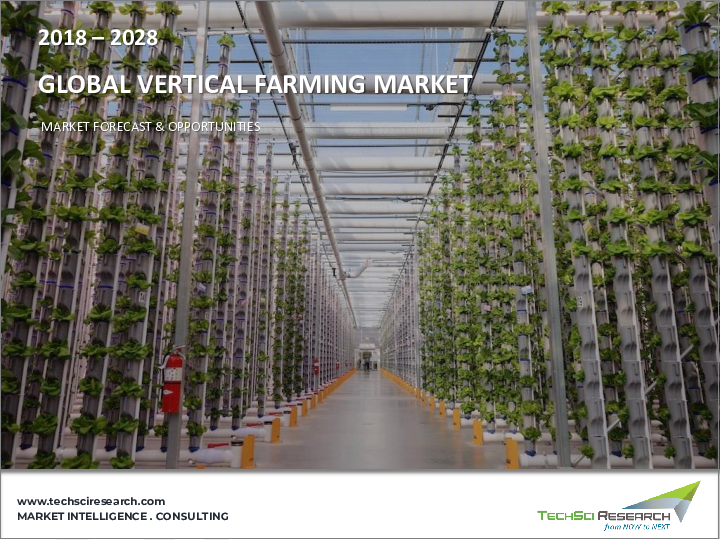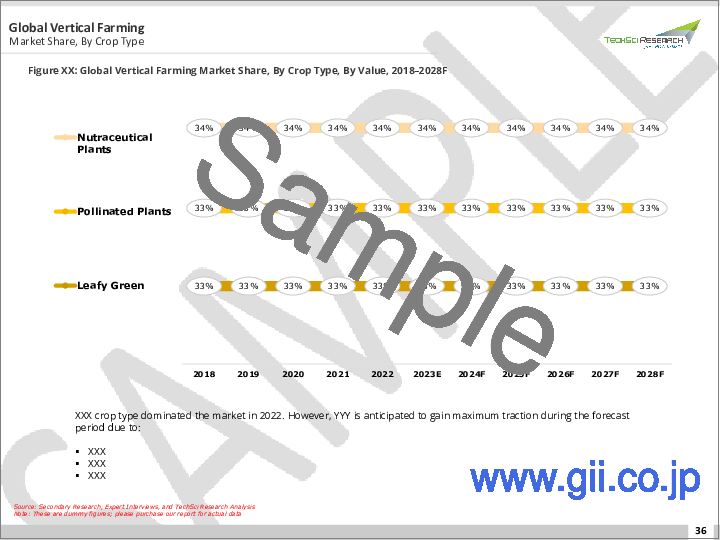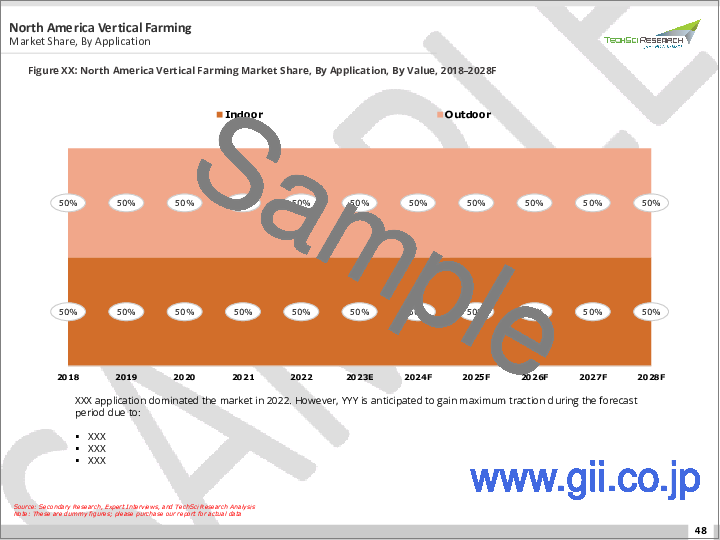|
|
市場調査レポート
商品コード
1342705
垂直農法市場-世界の産業規模、シェア、動向、機会、予測、2018-2028年Vertical Farming Market- Global Industry Size, Share, Trends, Opportunity, and Forecast, 2018-2028F Segmented By Structure, By Growing Mechanism, By Crop Type, By Component, By Application, By Region |
||||||
カスタマイズ可能
|
|||||||
| 垂直農法市場-世界の産業規模、シェア、動向、機会、予測、2018-2028年 |
|
出版日: 2023年08月01日
発行: TechSci Research
ページ情報: 英文 111 Pages
納期: 2~3営業日
|
- 全表示
- 概要
- 目次
世界の垂直農法市場は、健康的で安全な食品への需要の高まりにより、2028年まで大きく成長すると予測されています。
2019年、水耕栽培は世界の室内農業技術の市場価値の約51.33%を占めました。
健康で安全な食品への需要の高まり
栄養価が高く安全な食品に対するニーズの高まりにより、水耕栽培は例外的な成長を遂げると予想されます。水耕栽培の成長の原動力は、果物や野菜の味と持続可能性を高める発明の拡大です。この種の農法に対する需要は、水消費量の減少と生産可能量の増加によって煽られています。水耕栽培では、通常、土耕栽培よりも収穫量が多くなります。この技術を利用することで、土壌に影響を及ぼす病気の危険性が減少します。この技術では、植物の根を取り囲む土の代わりにミネラル溶液が使用されます。
例えば、国連砂漠化防止条約(UNCCD)によると、都市化の進展により、2000年から2030年の間に160万から330万ヘクタールの優良農地が失われると予想されています。
そのため、土地やスペースにあまり依存しない水耕栽培のような代替農法への需要が、今後の世界垂直農法市場の成長につながります。
コンテナ式垂直農法への需要の高まり
コンテナ型垂直農法の主な利点は、作物生産の全作業がコンテナ内で行われるため、輸送が簡単で土地が少なくて済むことです。1段の農地と比較すると、この栽培方法は約8倍の栽培スペースを提供し、都市の食糧安全保障が保証される期間を延ばすことができます。
例えば、2021年11月、バワリー・ファーミング社は、NASAのデータ駆動モデルに基づき、空き倉庫などの既存の構造物に組み込まれた都市型垂直農場を建設しました。
したがって、コンテナベースの農業に対する需要の増加は、予測期間中に世界の垂直農法市場の需要を拡大させる結果となります。
照明が主要コンポーネントとなる
垂直農法をサポートするために、照明システムには、LEDライト、ピンクライト、栽培ライト、栽培ライト安定器、栽培ライト反射器、その他の種類の人工栽培ライトが含まれ、運転経費を節約し、電力使用を制限します。LED照明システムは、ますます人気が高まっています。LED照明システムは、従来の光源よりも発熱量が少ないため、農業環境に最適です。
さらに、温度制御部品のニーズは、季節外れの食品に対する顧客需要のシフトによってもたらされています。温度調節コンポーネントは、湿度、照明、温度を調節するのに役立ちます。コンピューターやモバイル機器から高度な温度制御システムをコントロールできるため、水耕栽培用コンポーネントの開発に拍車がかかると予想されます。これらすべての要因が、予測数年間における世界の垂直農法市場の需要を増加させる。
利用可能なカスタマイズ
TechSci Research社は、所定の市場データを用いて、企業固有のニーズに応じたカスタマイズを提供しています。レポートでは以下のカスタマイズが可能です:
企業情報
- 追加市場参入企業(最大5社)の詳細分析とプロファイリング
目次
第1章 概要
第2章 調査手法
第3章 エグゼクティブサマリー
第4章 顧客の声
第5章 世界の垂直農法市場展望
- 市場規模・予測
- 金額別
- 市場シェアと予測
- 構造別(ビルベース、コンテナベース)
- 栽培メカニズム別(水耕栽培、エアロポニックス、アクアポニックス)
- 作物タイプ別(葉物植物、受粉植物、栄養補助植物)
- コンポーネント別(照明、水耕栽培コンポーネント、気候制御、センサー、その他)
- 用途別(屋内、屋外)
- 地域別(北米、欧州、アジア太平洋、南米、中東・アフリカ)
- 企業別(2022年)
- 市場マップ
- 構造別
- 栽培メカニズム別
- 作物タイプ別
- 成分別
- 用途別
- 地域別
第6章 北米垂直農法市場の展望
- 市場規模・予測
- 金額別
- 市場シェアと予測
- 構造別
- 栽培メカニズム別
- 作物タイプ別
- 成分別
- 用途別
- 国別
- 北米国別分析
- 米国
- メキシコ
- カナダ
第7章 欧州垂直農法市場の展望
- 市場規模・予測
- 金額別
- 市場シェア・予測
- 構造別
- 栽培メカニズム別
- 作物タイプ別
- 成分別
- 用途別
- 国別
- 欧州国別分析
- フランス
- ドイツ
- 英国
- スペイン
- イタリア
第8章 アジア太平洋垂直農法市場展望
- 市場規模・予測
- 金額別
- 市場シェアと予測
- 構造別
- 栽培メカニズム別
- 作物タイプ別
- 成分別
- 用途別
- 国別
- アジア太平洋地域国別分析
- 中国
- インド
- 韓国
- 日本
- シンガポール
第9章 南米垂直農法市場展望
- 市場規模・予測
- 金額別
- 市場シェア・予測
- 構造別
- 栽培メカニズム別
- 作物タイプ別
- 成分別
- 用途別
- 国別
- 南米:国別分析
- ブラジル
- アルゼンチン
第10章 中東・アフリカ垂直農法市場の展望
- 市場規模・予測
- 金額別
- 市場シェアと予測
- 構造別
- 栽培メカニズム別
- 作物タイプ別
- 成分別
- 用途別
- 国別
- MEA:国別分析
- 南アフリカ
- サウジアラビア
- アラブ首長国連邦
第11章 市場力学
- 促進要因
- 有機食品への需要の高まり
- 伝統的農業に利用可能な土地の制限
- 耕作地の減少と水不足の深刻化
- 課題
- 初期投資コストの高さ
- 園芸照明の複雑さ
第12章 市場動向と発展
- 製品の発売
- 合併と買収
- 技術の進歩
第13章 世界の垂直農法市場SWOT分析
第14章 ポーターのファイブフォース分析
- 業界内の競合
- 新規参入の可能性
- サプライヤーの力
- 顧客の力
- 代替品の脅威
第15章 競合情勢
- Business Overview
- Product Offerings
- Recent Developments
- Financials(In Case of Listed Companies)
- Key Personnel
- SWOT Analysis
- AeroFarms LLC
- AmHydro
- Urban Crop Solutions
- Bowery Farming Inc.
- Freight Farms, Inc.
- Crop One Holdings, Inc.
- Altius Farms, Inc.
- Plenty Unlimited Inc.
- Upward Enterprises Inc.
- Intelligent Growth Solutions Limited
第16章 戦略的提言
Global Vertical Farming market is anticipated to grow significantly through 2028 due to the growing demand for healthy and safe food. In 2019, Hydroponics made up around 51.33 % of the market value of indoor farming technology worldwide.
The increased demand for organic and high-quality foods has changed the production capacity of vertical farming businesses and given them a foundation to assure high-quality and quantity-authorized production to satisfy the growing needs. In addition, individuals have begun growing fruits and vegetables indoors, giving rise to the idea of indoor vertical farming resulting in the growth of global vertical farming market in the forecast period.
Increasing Demand for Healthy and Safe Food
Due to the rising need for nutritious and secure food, hydroponics is expected to experience exceptional growth. Growth in hydroponics is driven by expanding inventions to enhance the tastes and sustainability of fruits and vegetables. The demand for this kind of farming method is fueled by decreased water consumption and increased output potential. When grown hydroponically, plants typically yield more than those that are grown in soil. By utilizing this technique, the danger of illnesses that affect soil is decreased. In this technique, a mineral solution is used in lieu of the soil to surround the roots of the plant.
For instance, according to United Nations Convention to Combat Desertification (UNCCD), due to an increase in urbanization annual loss of 1.6 to 3.3 million hectares of prime agricultural land between 2000 and 2030 is expected.
Therefore, the demand for alternative farming practices such as hydroponics which are less dependent on land and space leads to the growth of Global Vertical Farming Market in the upcoming years.
Growing Demand for Container-Based Vertical Farming
The key advantages of container-based farming are that the entire operation of crop production is done in a container, making it simple to transport and requiring less land. In comparison to single-level agricultural land, this method of cultivation offers roughly eight times as much growing space, extending the time during which a city's food security is guaranteed.
For instance, in November 2021, Bowery Farming built urban vertical farms, based on NASA's data-driven model, built into existing structures such as vacant warehouses.
Therefore, increasing demand for container-based farming results in growing the demand of Global Vertical Farming market during the projected period.
Lighting will be the Key Component
In order to support vertical farming, the lighting system includes LED lights, pink lights, grow lights, grow light ballasts, grow light reflectors, and other kinds of artificial cultivation lights which save operating expenses and limit power usage. LED lighting systems are becoming more and more popular. LED lighting systems produce less heat than traditional light sources, making them perfect for agricultural settings.
Furthermore, the need for temperature control components is driven by a shift in customer demand for out-of-season food. Components of climate control aid in regulating the humidity, lighting, and temperature. The ability to control sophisticated temperature control systems from a computer or mobile device is anticipated to spur the development of hydroponics components. All these factors increase the demand for Global Vertical Farming market in the forecast years.
Recent Developments
- In November 2022, AeroFarms and QFZA Announced the Middle East Expansion of AeroFarms with a New Commercial Indoor Vertical Farm in Qatar Free Zones.
- Bowery opened a new vertical farm in Pennsylvania in May 2022.
- In the Ica Maxi superstore in Linkoping, Sweden, Swegreen debuted the "NextGen" of very effective in-store vertical farms in April 2021.
- In October 2020, Bright Farms assured USD100 million to expand its indoor farming.
Market Segmentation
Global Vertical Farming Market is segmented based on structure, growing mechanism, crop type, component, application, region and Competitive Landscape. Based on structure, the market is categorized into building-based and container-based. Based on growing mechanism, the market is divided into hydroponics, aeroponics, and aquaponics Based on crop type, the market is fragmented into leafy green, pollinated plants, and nutraceutical plants. Based on application, the market is segregated into indoor, and outdoor. Based on region, the market is divided into North America, Europe, Asia Pacific, South America, Middle East & Africa.
Company Profiles
AeroFarms LLC, AmHydro, Urban Crop Solutions, Bowery Farming Inc., Freight Farms, Inc., Crop One Holdings, Inc., Altius Farms, Inc., Plenty Unlimited Inc., Upward Enterprises Inc., Intelligent Growth Solutions Limited are some of the key players in the Global Vertical Farming Market.
Report Scope
In this report, Global Vertical Farming market has been segmented into the following categories, in addition to the industry trends, which have also been detailed below:
Vertical Farming Market, By Structure:
- Building-Based
- Container-Based
Vertical Farming Market, By Growing Mechanism:
- Hydroponics
- Aeroponics
- Aquaponics
Vertical Farming Market, By Crop Type:
- Leafy Green
- Pollinated Plants
- Nutraceutical Plants
Vertical Farming Market, By Component:
- Lighting
- Hydroponic Component
- Climate Control
- Sensors
- Others
Vertical Farming Market, By Application:
- Indoor
- Outdoor
Vertical Farming Market, By Region:
- North America
- United States
- Mexico
- Canada
- Europe
- France
- Germany
- United Kingdom
- Spain
- Italy
- Asia-Pacific
- China
- India
- South Korea
- Japan
- Singapore
- South America
- Brazil
- Argentina
- Middle East & Africa
- South Africa
- Saudi Arabia
- UAE
Competitive Landscape
Company Profiles: Detailed analysis of the major companies in global vertical farming market.
Available Customizations
With the given market data, TechSci Research offers customizations according to a company's specific needs. The following customization options are available for the report:
Company Information
- Detailed analysis and profiling of additional market players (up to five).
Table of Contents
1. Product Overview
- 1.1. Market Definition
- 1.2. Scope of the Market
- 1.2.1. Markets Covered
- 1.2.2. Years Considered for Study
- 1.2.3. Key Market Segmentations
2. Research Methodology
- 2.1. Objective of the Study
- 2.2. Baseline Methodology
- 2.3. Key Industry Partners
- 2.4. Major Association and Secondary Sources
- 2.5. Forecasting Methodology
- 2.6. Data Triangulation & Validation
- 2.7. Assumptions and Limitations
3. Executive Summary
- 3.1. Overview of the Market
- 3.2. Overview of Key Market Segmentations
- 3.3. Overview of Key Market Players
- 3.4. Overview of Key Regions/Countries
- 3.5. Overview of Market Drivers, Challenges, Trends
4. Voice of Customer
5. Global Vertical Farming Market Outlook
- 5.1. Market Size & Forecast
- 5.1.1. By Value
- 5.2. Market Share & Forecast
- 5.2.1. By Structure (Building-Based, Container-Based)
- 5.2.2. By Growing Mechanism (Hydroponics, Aeroponics, Aquaponics)
- 5.2.3. By Crop Type (Leafy Green, Pollinated Plants, Nutraceutical Plants)
- 5.2.4. By Component (Lighting, Hydroponic Component, Climate Control, Sensors, Others)
- 5.2.5. By Application (Indoor, Outdoor)
- 5.2.6. By Region (North America, Europe, Asia Pacific, South America, Middle East & Africa)
- 5.2.7. By Company (2022)
- 5.3. Market Map
- 5.3.1. By Structure
- 5.3.2. By Growing Mechanism
- 5.3.3. By Crop Type
- 5.3.4. By Component
- 5.3.5. By Application
- 5.3.6. By Region
6. North America Vertical Farming Market Outlook
- 6.1. Market Size & Forecast
- 6.1.1. By Value
- 6.2. Market Share & Forecast
- 6.2.1. By Structure
- 6.2.2. By Growing Mechanism
- 6.2.3. By Crop Type
- 6.2.4. By Component
- 6.2.5. By Application
- 6.2.6. By Country
- 6.3. North America: Country Analysis
- 6.3.1. United States Vertical Farming Market Outlook
- 6.3.1.1. Market Size & Forecast
- 6.3.1.1.1. By Value
- 6.3.1.2. Market Share & Forecast
- 6.3.1.2.1. By Structure
- 6.3.1.2.2. By Growing Mechanism
- 6.3.1.2.3. By Crop Type
- 6.3.1.2.4. By Component
- 6.3.1.2.5. By Application
- 6.3.1.1. Market Size & Forecast
- 6.3.2. Mexico Vertical Farming Market Outlook
- 6.3.2.1. Market Size & Forecast
- 6.3.2.1.1. By Value
- 6.3.2.2. Market Share & Forecast
- 6.3.2.2.1. By Structure
- 6.3.2.2.2. By Growing Mechanism
- 6.3.2.2.3. By Crop Type
- 6.3.2.2.4. By Component
- 6.3.2.2.5. By Application
- 6.3.2.1. Market Size & Forecast
- 6.3.3. Canada Vertical Farming Market Outlook
- 6.3.3.1. Market Size & Forecast
- 6.3.3.1.1. By Value
- 6.3.3.2. Market Share & Forecast
- 6.3.3.2.1. By Structure
- 6.3.3.2.2. By Growing Mechanism
- 6.3.3.2.3. By Crop Type
- 6.3.3.2.4. By Component
- 6.3.3.2.5. By Application
- 6.3.3.1. Market Size & Forecast
- 6.3.1. United States Vertical Farming Market Outlook
7. Europe Vertical Farming Market Outlook
- 7.1. Market Size & Forecast
- 7.1.1. By Value
- 7.2. Market Share & Forecast
- 7.2.1. By Structure
- 7.2.2. By Growing Mechanism
- 7.2.3. By Crop Type
- 7.2.4. By Component
- 7.2.5. By Application
- 7.2.6. By Country
- 7.3. Europe: Country Analysis
- 7.3.1. France Vertical Farming Market Outlook
- 7.3.1.1. Market Size & Forecast
- 7.3.1.1.1. By Value
- 7.3.1.2. Market Share & Forecast
- 7.3.1.2.1. By Structure
- 7.3.1.2.2. By Growing Mechanism
- 7.3.1.2.3. By Crop Type
- 7.3.1.2.4. By Component
- 7.3.1.2.5. By Application
- 7.3.1.1. Market Size & Forecast
- 7.3.2. Germany Vertical Farming Market Outlook
- 7.3.2.1. Market Size & Forecast
- 7.3.2.1.1. By Value
- 7.3.2.2. Market Share & Forecast
- 7.3.2.2.1. By Structure
- 7.3.2.2.2. By Growing Mechanism
- 7.3.2.2.3. By Crop Type
- 7.3.2.2.4. By Component
- 7.3.2.2.5. By Application
- 7.3.2.1. Market Size & Forecast
- 7.3.3. United Kingdom Vertical Farming Market Outlook
- 7.3.3.1. Market Size & Forecast
- 7.3.3.1.1. By Value
- 7.3.3.2. Market Share & Forecast
- 7.3.3.2.1. By Structure
- 7.3.3.2.2. By Growing Mechanism
- 7.3.3.2.3. By Crop Type
- 7.3.3.2.4. By Component
- 7.3.3.2.5. By Application
- 7.3.3.1. Market Size & Forecast
- 7.3.4. Spain Vertical Farming Market Outlook
- 7.3.4.1. Market Size & Forecast
- 7.3.4.1.1. By Value
- 7.3.4.2. Market Share & Forecast
- 7.3.4.2.1. By Structure
- 7.3.4.2.2. By Growing Mechanism
- 7.3.4.2.3. By Crop Type
- 7.3.4.2.4. By Component
- 7.3.4.2.5. By Application
- 7.3.4.1. Market Size & Forecast
- 7.3.5. Italy Vertical Farming Market Outlook
- 7.3.5.1. Market Size & Forecast
- 7.3.5.1.1. By Value
- 7.3.5.2. Market Share & Forecast
- 7.3.5.2.1. By Structure
- 7.3.5.2.2. By Growing Mechanism
- 7.3.5.2.3. By Crop Type
- 7.3.5.2.4. By Component
- 7.3.5.2.5. By Application
- 7.3.5.1. Market Size & Forecast
- 7.3.1. France Vertical Farming Market Outlook
8. Asia-Pacific Vertical Farming Market Outlook
- 8.1. Market Size & Forecast
- 8.1.1. By Value
- 8.2. Market Share & Forecast
- 8.2.1. By Structure
- 8.2.2. By Growing Mechanism
- 8.2.3. By Crop Type
- 8.2.4. By Component
- 8.2.5. By Application
- 8.2.6. By Country
- 8.3. Asia-Pacific: Country Analysis
- 8.3.1. China Vertical Farming Market Outlook
- 8.3.1.1. Market Size & Forecast
- 8.3.1.1.1. By Value
- 8.3.1.2. Market Share & Forecast
- 8.3.1.2.1. By Structure
- 8.3.1.2.2. By Growing Mechanism
- 8.3.1.2.3. By Crop Type
- 8.3.1.2.4. By Component
- 8.3.1.2.5. By Application
- 8.3.1.1. Market Size & Forecast
- 8.3.2. India Vertical Farming Market Outlook
- 8.3.2.1. Market Size & Forecast
- 8.3.2.1.1. By Value
- 8.3.2.2. Market Share & Forecast
- 8.3.2.2.1. By Structure
- 8.3.2.2.2. By Growing Mechanism
- 8.3.2.2.3. By Crop Type
- 8.3.2.2.4. By Component
- 8.3.2.2.5. By Application
- 8.3.2.1. Market Size & Forecast
- 8.3.3. South Korea Vertical Farming Market Outlook
- 8.3.3.1. Market Size & Forecast
- 8.3.3.1.1. By Value
- 8.3.3.2. Market Share & Forecast
- 8.3.3.2.1. By Structure
- 8.3.3.2.2. By Growing Mechanism
- 8.3.3.2.3. By Crop Type
- 8.3.3.2.4. By Component
- 8.3.3.2.5. By Application
- 8.3.3.1. Market Size & Forecast
- 8.3.4. Japan Vertical Farming Market Outlook
- 8.3.4.1. Market Size & Forecast
- 8.3.4.1.1. By Value
- 8.3.4.2. Market Share & Forecast
- 8.3.4.2.1. By Structure
- 8.3.4.2.2. By Growing Mechanism
- 8.3.4.2.3. By Crop Type
- 8.3.4.2.4. By Component
- 8.3.4.2.5. By Application
- 8.3.4.1. Market Size & Forecast
- 8.3.5. Singapore Vertical Farming Market Outlook
- 8.3.5.1. Market Size & Forecast
- 8.3.5.1.1. By Value
- 8.3.5.2. Market Share & Forecast
- 8.3.5.2.1. By Structure
- 8.3.5.2.2. By Growing Mechanism
- 8.3.5.2.3. By Crop Type
- 8.3.5.2.4. By Component
- 8.3.5.2.5. By Application
- 8.3.5.1. Market Size & Forecast
- 8.3.1. China Vertical Farming Market Outlook
9. South America Vertical Farming Market Outlook
- 9.1. Market Size & Forecast
- 9.1.1. By Value
- 9.2. Market Share & Forecast
- 9.2.1. By Structure
- 9.2.2. By Growing Mechanism
- 9.2.3. By Crop Type
- 9.2.4. By Component
- 9.2.5. By Application
- 9.2.6. By Country
- 9.3. South America: Country Analysis
- 9.3.1. Brazil Vertical Farming Market Outlook
- 9.3.1.1. Market Size & Forecast
- 9.3.1.1.1. By Value
- 9.3.1.2. Market Share & Forecast
- 9.3.1.2.1. By Structure
- 9.3.1.2.2. By Growing Mechanism
- 9.3.1.2.3. By Crop Type
- 9.3.1.2.4. By Component
- 9.3.1.2.5. By Application
- 9.3.1.1. Market Size & Forecast
- 9.3.2. Argentina Vertical Farming Market Outlook
- 9.3.2.1. Market Size & Forecast
- 9.3.2.1.1. By Value
- 9.3.2.2. Market Share & Forecast
- 9.3.2.2.1. By Structure
- 9.3.2.2.2. By Growing Mechanism
- 9.3.2.2.3. By Crop Type
- 9.3.2.2.4. By Component
- 9.3.2.2.5. By Application
- 9.3.2.1. Market Size & Forecast
- 9.3.1. Brazil Vertical Farming Market Outlook
10. Middle East and Africa Vertical Farming Market Outlook
- 10.1. Market Size & Forecast
- 10.1.1. By Value
- 10.2. Market Share & Forecast
- 10.2.1. By Structure
- 10.2.2. By Growing Mechanism
- 10.2.3. By Crop Type
- 10.2.4. By Component
- 10.2.5. By Application
- 10.2.6. By Country
- 10.3. MEA: Country Analysis
- 10.3.1. South Africa Vertical Farming Market Outlook
- 10.3.1.1. Market Size & Forecast
- 10.3.1.1.1. By Value
- 10.3.1.2. Market Share & Forecast
- 10.3.1.2.1. By Structure
- 10.3.1.2.2. By Growing Mechanism
- 10.3.1.2.3. By Crop Type
- 10.3.1.2.4. By Component
- 10.3.1.2.5. By Application
- 10.3.1.1. Market Size & Forecast
- 10.3.2. Saudi Arabia Vertical Farming Market Outlook
- 10.3.2.1. Market Size & Forecast
- 10.3.2.1.1. By Value
- 10.3.2.2. Market Share & Forecast
- 10.3.2.2.1. By Structure
- 10.3.2.2.2. By Growing Mechanism
- 10.3.2.2.3. By Crop Type
- 10.3.2.2.4. By Component
- 10.3.2.2.5. By Application
- 10.3.2.1. Market Size & Forecast
- 10.3.3. UAE Vertical Farming Market Outlook
- 10.3.3.1. Market Size & Forecast
- 10.3.3.1.1. By Value
- 10.3.3.2. Market Share & Forecast
- 10.3.3.2.1. By Structure
- 10.3.3.2.2. By Growing Mechanism
- 10.3.3.2.3. By Crop Type
- 10.3.3.2.4. By Component
- 10.3.3.2.5. By Application
- 10.3.3.1. Market Size & Forecast
- 10.3.1. South Africa Vertical Farming Market Outlook
11. Market Dynamics
- 11.1. Drivers
- 11.1.1. Growing Demand for Organic Food
- 11.1.2. Limited Land Availability for Traditional Agriculture
- 11.1.3. Decreasing Arable Land and Increasing Water Crisis
- 11.2. Challenges
- 11.2.1. High cost of initial investment
- 11.2.2. Complexity of Horticulture Lighting
12. Market Trends & Developments
- 12.1. Product Launches
- 12.2. Mergers & Acquisitions
- 12.3. Technological Advancements
13. Global Vertical Farming Market: SWOT Analysis
14. Porter's Five Forces Analysis
- 14.1. Competition in the Industry
- 14.2. Potential of New Entrants
- 14.3. Power of Suppliers
- 14.4. Power of Customers
- 14.5. Threat of Substitute Products
15. Competitive Landscape
- 15.1. Business Overview
- 15.2. Product Offerings
- 15.3. Recent Developments
- 15.4. Financials (In Case of Listed Companies)
- 15.5. Key Personnel
- 15.6. SWOT Analysis
- 15.6.1. AeroFarms LLC
- 15.6.2. AmHydro
- 15.6.3. Urban Crop Solutions
- 15.6.4. Bowery Farming Inc.
- 15.6.5. Freight Farms, Inc.
- 15.6.6. Crop One Holdings, Inc.
- 15.6.7. Altius Farms, Inc.
- 15.6.8. Plenty Unlimited Inc.
- 15.6.9. Upward Enterprises Inc.
- 15.6.10. Intelligent Growth Solutions Limited






